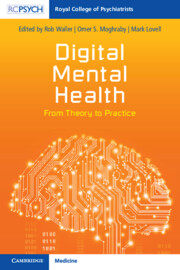Book contents
- Digital Mental Health
- Digital Mental Health
- Copyright page
- Contents
- Contributors
- Introduction
- Chapter 1 Working with IT Systems
- Chapter 2 Technology-Enabled Care
- Chapter 3 Note Keeping in the Digital Age
- Chapter 4 Big Data
- Chapter 5 Artificial Intelligence
- Chapter 6 Digital Clinicians
- Chapter 7 Global Telepsychiatry
- Chapter 8 The Integration Agenda
- Chapter 9 Digital Wellbeing
- Chapter 10 Conclusion
- Appendix: Abbreviations
- Index
- References
Chapter 2 - Technology-Enabled Care
Published online by Cambridge University Press: 23 November 2023
- Digital Mental Health
- Digital Mental Health
- Copyright page
- Contents
- Contributors
- Introduction
- Chapter 1 Working with IT Systems
- Chapter 2 Technology-Enabled Care
- Chapter 3 Note Keeping in the Digital Age
- Chapter 4 Big Data
- Chapter 5 Artificial Intelligence
- Chapter 6 Digital Clinicians
- Chapter 7 Global Telepsychiatry
- Chapter 8 The Integration Agenda
- Chapter 9 Digital Wellbeing
- Chapter 10 Conclusion
- Appendix: Abbreviations
- Index
- References
Summary
Having ideas is easy for technology-enabled care, but implementing them is hard. The chances of success can be improved by building a broad coalition of essential stakeholders, persuading the sceptical, respecting your information governance colleagues, careful planning, and thinking about and minimising risks. Leadership, strategic thinking, persuasion, attention to detail and a team approach are needed. Professional project management, good marketing and communication are vital for implementation, and a robust evaluation is essential for sustainability.
Keywords
- Type
- Chapter
- Information
- Digital Mental HealthFrom Theory to Practice, pp. 22 - 40Publisher: Cambridge University PressPrint publication year: 2023



